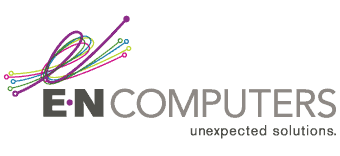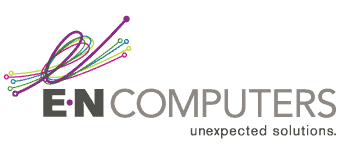
 by Ian MacRae
by Ian MacRae
President and CEO, E-N Computers
23+ years experience solving business IT problems in Virginia and Washington, D.C.
As an owner or office manager of a small business, you probably feel like you don’t have enough time to accomplish all of your responsibilities in a day. It can feel like all you’re doing is putting out fires with no time to do the planning that will grow and stabilize your business long-term.
Though technology is essential to running a modern business, it often gets in the way of doing other important things. Implementing new tech or troubleshooting what you already have can be a significant drain on your limited time and resources. You need technology to work for you, rather than slaving over it.
In the early days of your business, it might have been feasible to fiddle with your IT setup and get the basics running. As your business grows, adds employees, and establishes processes, that kind of tweaking becomes a full-time job on its own. If you continue to attempt to maintain your IT infrastructure by yourself, you not only limit your ability to do things that will have a great impact on your business — you open yourself up to risk and liability by having systems that are not up-to-date or secure.
Time and again, we have seen businesses struggle under the weight of IT infrastructure that can no longer be properly maintained by an owner with a wide range of responsibilities. We firmly believe the success of your business relies on your ability to delegate this responsibility to either a dedicated IT person or a managed service provider. So today we want to talk a bit about how owners can do this and what the benefits are.
QUICK ANSWER:
Why should small business owners stop doing IT support?
In the early days of your business, it might have been feasible to fiddle with your IT setup and get the basics running. As your business grows, adds employees, and establishes processes, that kind of tweaking becomes a full-time job. If you keep trying to maintain your IT infrastructure on your own, you’ll hurt your business and your IT.
Delegate your IT support
When you start a business, you’re responsible for everything. But as the business grows, it’s simply not sustainable to continue involving yourself in the nitty-gritty details of every part of the business. Instead, you really have to delegate essential functions to other responsible parties. However, many business leaders are hesitant to delegate.
Some leaders do not like the idea of delegating because they don’t want to lose control, feel they can do the work more quickly on their own, or otherwise don’t trust others to do good work. Although these are common feelings, they are bad for the growth and success of a business. You cannot grow while doing everything on your own; good, qualified people are unlikely to stay around if they feel you do not trust their work.
Successful delegation, then, requires both trust and training. Entrust capable employees with added responsibilities, looking for ways that their skills and aptitudes align with what you need to get done. Make sure that their pay reflects the value they are providing you. When you delegate tasks, you can start small and gradually increase them. By setting clear expectations, giving some leeway, and providing all necessary resources, you will be more likely to see success.
When you assign essential tasks to others, let them know the frequency and detail of progress reports you expect. Schedule a review at the end of each project so that you can see what went well and what could be improved in the future. This provides you a way to stay involved and your employee an opportunity to reflect while gaining confidence and ability.
How to stay involved while delegating
While the concept of delegation is applicable to any part of your business, I want to focus a little more on how you can stay involved in the IT side of things without having to be too involved. It comes down to focusing on business processes and requirements rather than technical implementation.
Here are some examples of decisions where executive decisions need to be made:
- employee roles
- rights and privileges based on roles
- types of equipment available based on roles
- processes and procedures within and across departments
- other data-driven decisions
Let’s dig into these a little more. You want each of your employees to have clearly defined roles and responsibilities. This helps with deciding what systems and data they need access to. Then your technical staff or vendor can ensure that they have what they need to do their work — no more and no less.
Based on their roles, your employees may work in the office, the field, at home, or some combination of these. Where they work and the software they use will affect decisions about the equipment they need. Office-only may just need a desktop, field workers a laptop, home workers might be given an option. If someone works on-the-go and at a desk, they might use a laptop plus docking station. Setting these broad rules and then letting technical staff hammer out the specifics, will free you up for other important work.
One caution here: some people allow excitement about new technology to drive their implementation and purchase decisions, rather than choosing what will be the most reliable and suitable for the business. If that describes you or your technical staff, try to control that urge. We need to stay up to date for security and support purposes but living at the bleeding edge of technology will cut you more often than not.
Improve processes while stepping back
 Just because you’re not in the trenches of technical implementation (or other parts of the business) doesn’t mean you can’t continue to improve processes. There are a few key areas you can and should continue to keep an eye on.
Just because you’re not in the trenches of technical implementation (or other parts of the business) doesn’t mean you can’t continue to improve processes. There are a few key areas you can and should continue to keep an eye on.
Documentation. Across disciplines, documentation is often neglected when people are overextended. This creates a problem where only one person knows and understands complex systems that the business relies on. Then, it becomes difficult to mentally track every detail as systems are updated and reconfigured.
By taking a step back from implementing technical systems, you can focus on making sure that they — and the rest of your business processes — are well-documented. This includes documenting staff roles, how work is done, how systems are configured and used, and fallback (manual) processes to use when technology fails.
Ticketing. Ticketing improves the quality of your IT support because it:
- tracks progress on open issues
- provides data on task volume, response time, and resolution time and
- provides data on sources of recurring problems such as hardware, software, and particular users.
By establishing a ticketing system and expecting all employees to use it when requesting support, you can eliminate unaddressed problems plus shorten the amount of time it takes for the initial response and final resolution of many issues. You’ll also have the data you need to decide how much IT support you need, either by hiring additional IT staff or contracting with a managed service provider (MSP) like E-N Computers. Ticketing helps you see where systems and processes can be improved, as well as when employees may need more training. It is an invaluable source of data that you can use in decision-making.
Service Level Agreement. Service level agreements also improve IT outcomes by setting standards for first response time (FRT), time to resolution (TTR), and escalation procedures. They can exist between departments (e.g. Accounting and IT) and between companies (e.g. you and your MSP). An IT SLA makes sure that IT responds to issues in a timely manner according to their impact and urgency. It also provides IT breathing room to prioritize and address issues.
When an SLA sets clear expectations, it can improve interdepartmental relationships, problem resolution, and overall productivity. You can also measure your actual response and resolution times against the SLA, as well as track the number of high-priority tasks. Often, this data will show potential areas of improvement.
Redirect your analytical skills
As your business grows, it will become harder and harder to get your hands dirty the way you did early on. Instead, you will have to learn to rely on the work, insights, and data provided by others. Creating processes, documenting them, and measuring the results is a powerful way of significantly impacting all parts of your business.
These same principles are true if you already have an IT person that is overwhelmed by the day-to-day problem solving and has a mounting stack of important-but-neglected projects. By outsourcing IT to a managed service provider, you can redirect your IT professional’s skills into process refinement, reporting, and data analysis.
Including a technically minded person on your leadership team can change the way your entire team thinks about technology’s ability to drive company success. Perhaps you started on a project previously and IT was brought in later, after key decisions had already been made. It likely added to the time and effort required to complete the project — if it could be done at all! When technical details are considered from the start, though, projects can move forward more steadily and with a higher likelihood of success.
Why you might need outside help
A managed service provider like E-N Computers can provide both surge capacity and ongoing support to your business. If you have a handle on most day-to-day IT functions but need some additional capacity to complete a large project, we can help with that. For example, we’ve helped clients set up ticketing systems, document their network infrastructure, and refresh servers and workstations.
READ: How Much Does IT Support Cost?
READ: Should You Build or Buy an IT Department?
We also provide IT assessment and auditing services to help you discover easy ways to improve your IT, as well as set longer-term goals to enable future growth. Try out our free IT Self-Assessment to get some suggested action items for improving your IT. After completing the assessment, you’ll also have the option of booking a free, no-obligation strategy session to discuss your results.
Take the IT Maturity Assessment

Is your business ready to weather changes, including employee turnover? Find out by taking our IT maturity assessment.
You’ll get personalized action items that you can use to make improvements right away. Plus, you’ll have the opportunity to book a FREE IT strategy session to get even more insights into your IT needs.

Industries
Locations
Waynesboro, VA
Corporate HQ
215 Fifth St.
Waynesboro, VA 22980
Sales: 540-217-6261
Service: 540-885-3129
Accounting: 540-217-6260
Fax: 703-935-2665
Washington D.C.
1126 11th ST. NW
Suite 603
Washington, DC 20001-4366
Sales: 202-888-2770
Service: 866-692-9082
VA DCJS # 11-6604
Locations
Harrisonburg, VA
45 Newman Ave.
Harrisonburg, VA 22801
Sales: 540-569-3465
Service: 866-692-9082
Richmond, VA
3026A W. Cary St.
Richmond, VA 23221
Sales: 804-729-8835
Service: 866-692-9082
